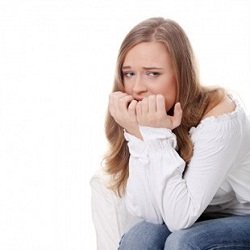What is anxiety disorder?
 Today, every fifth person has anxiety disorder and, according to statistics, 70% of primary appeals to the therapist are psychosomatics. There are also such statistics: 70% of suicides had had a doctor appointment six months before suicide. And the doctor says: "you have vegetative dystonia, osteochondrosis." He does not even raise an eye on a man; he does not understand that patient came for help. But the problem is that patients still go not to a psychiatrist, but to a therapist. So what is anxiety disorder and what are the symptoms?
Today, every fifth person has anxiety disorder and, according to statistics, 70% of primary appeals to the therapist are psychosomatics. There are also such statistics: 70% of suicides had had a doctor appointment six months before suicide. And the doctor says: "you have vegetative dystonia, osteochondrosis." He does not even raise an eye on a man; he does not understand that patient came for help. But the problem is that patients still go not to a psychiatrist, but to a therapist. So what is anxiety disorder and what are the symptoms?
It is a universal adaptive response of an organism to stimuli that potentially carry a threat or are new to the subject. This reaction is designed to mobilize the body's basic reserves through the activation of the hypothalamo-hypophyseal-adrenal axis in order to respond most quickly to changed environmental conditions and avoidance of danger.
To date, there are two main approaches to explaining the concept of anxiety and its relationship to fear, panic and stress. On the one hand, there is an opinion that anxiety is a learned kind of fear for all life-threatening stimuli, on the other only on certain incentives that are associated with punishment and frustration. Depending on these two approaches, a hypothesis was formulated on two variants of anxiety. First of all, we are talking about anxious experiences that are characterized by negative expectations in relation to the future and have a pronounced cognitive component, and an active anxiety disorder characterized by the emergence of an intense immediate fear reaction, panic attacks with the corresponding somatic manifestations (rapid heartbeat and breathing, increased sweating, strengthened intestinal peristalsis, etc.).
Anxiety disorder can be both normal (physiological) and pathological reaction of the organism to changing environmental conditions. In the first case, anxiety is a temporary sensation and depends on the duration of the traumatic situation. At the same time, the intensity of anxiety correlates with the subjective significance of the event. Unlike physiological pathological anxiety disorder is characterized by groundless anxiety, which can take the form of feelings of impending danger, internal tension, and expectation of unforeseen events. In this case, the emergence of anxiety in response to stressful events, but this reaction is hypertrophic and maladaptive.
Pathological form is also characterized by somatization of affect in the form of a violation of the function of any system of the body, chronic weakness, pain and unusual sensations and other manifestations. It should be noted that there are experimental confirmations of the effect of long conflict situations on the formation of psychosomatic diseases. In this regard, scientists have identified a separate group of organic diseases in the development of which the primary role played by the characteristics of mental response to stressful stimuli. These psychosomatisms primarily include bronchial asthma, coronary heart disease, peptic ulcer, neurodermatitis, scleroderma and psoriasis.
Among all mental disorders, anxiety disorder is the most common. Most patients with this diagnosis in most cases receive outpatient care and significantly less attention of doctors than those with more "serious" diseases, such as schizophrenia or bipolar affective disorder. In addition, most people with anxiety disorders do not seek medical help at all, which does not allow understanding the real picture of the prevalence of this disease.
To date, there are several basic approaches to explaining the causes of anxiety disorders. Approaches can be roughly divided into three large groups: psychological, neurobiological and genetic theories of the formation of pathological anxiety.
In the treatment of anxiety disorders, a variety of medications can be used, many of which have become available in the last three decades. Treating is divided into several stages: acute phase therapy, stabilization, maintenance and preventive therapy. The main task at the first stage is to achieve rapid control over the symptoms of an anxiety disorder. The next phase is characterized by the achievement of sufficient and prolonged changes in the patient's condition to create favorable conditions for recovery, as well as to prevent possible complications. At this stage, the dose of the drug is adjusted, for example, a decrease in the dose when unwanted side effects appear or an increase in the appearance of sub-syndromal symptoms. Treatment in the phase of maintenance therapy is aimed at the full restoration of psychological, social and labor functioning, maintaining a stable emotional state and preventing relapse. At this stage, there is usually no need for additional therapy and a gradual dose reduction occurs. Treatment in the last phase of preventive therapy is aimed at preventing relapse.
If to talk about medications for anxiety disorder then the most helpful for the last years are:
- Fluoxetine;
- Fluvoxamine;
- Sertraline;
- Trazodone;
- Agomelatine;
- Venlafaxine;
- Duloxetine;
- Buspar.